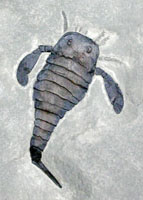Eurypterids, or water scoprions, were aquatic predators that thrived until the end of the Paleozoic Era for about 250 million years. Eurypterids primarily lived in brackish water in lagoons and estuaries, feeding on everything from mollusks to primitive fish. According to fossil trackways found in Australia, eurypterids could also spend time on land, and were likely the first animals to leave the water.
Euryterids are part of an extinct order of Arthropods. They were closely related to insects, spiders, crabs, and other Arthropods. All Arthropods have a chitinous exoskeleton and jointed limbs. Unlike other Arthropods, eurypterids had five pairs of legs. On the genus Eurypterus, the first four pairs of legs were used for walking and the fifth pair was modified into a set of paddle-like flippers. Most eurypterids were equipped with a telson at the end of the tail. The telson was a stinger which was probably capable of secreting poisons. The gills of eurypterids were located on the underside of the belly, underneath the plates of the midsection. These plates could probably open and close, forcing water through the gills and aiding in locomotion.
Eutypterus is one of the most recognizable eurypterids. It survived from the Ordovician Period to the Permian Period throughout Europe and North America. This specimen is a replica of Eurypterus remipes from the Upper Silurian Period. The original fossil was found in the 420 million year old Fiddlers Green Formation of Herkimer County, New York.
An original Eurypterus of this size and quality would retail for about $800.00 or more, plus $100.00 more for the frame.
Eurypterus remipes 
Quantity in Basket: None
Code: ART-400
Price: $158.00
Shipping Weight: 1.60 pounds
Time: Upper Silurian, approximately 420 million years ago.
Location: Fiddlers Green Formation of New York, USA.
Dimensions: 11-3/*4" x 9-1/2" x 1-1/2"